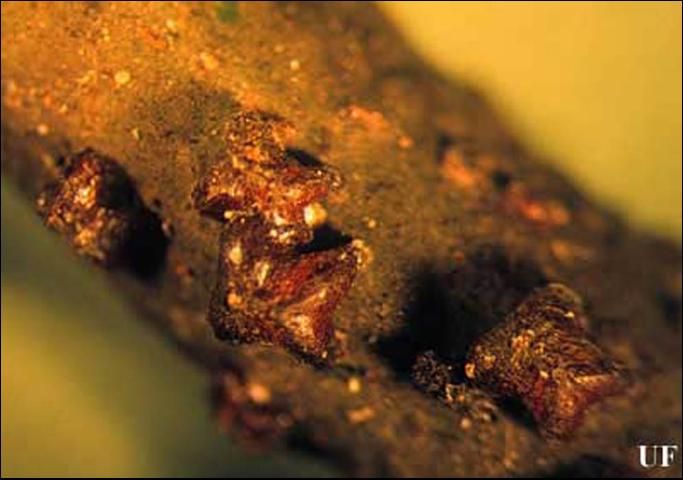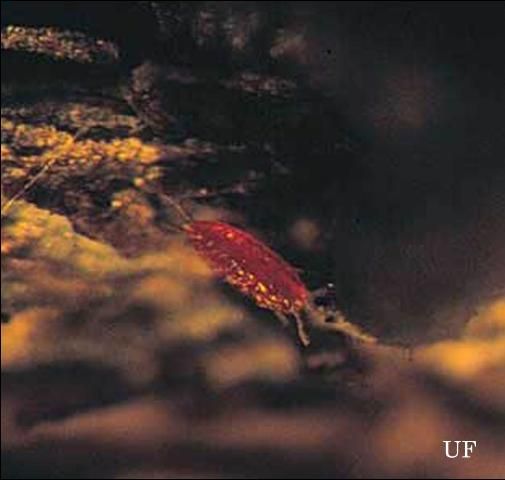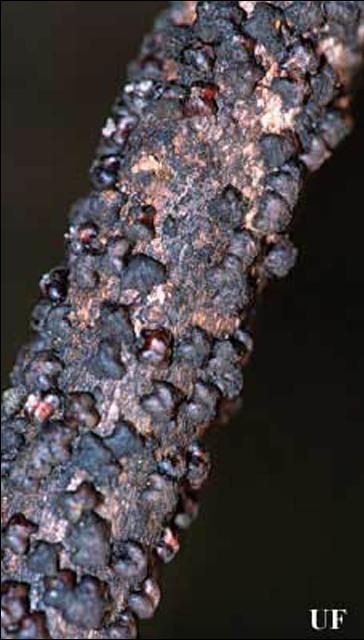The Featured Creatures collection provides in-depth profiles of insects, nematodes, arachnids and other organisms relevant to Florida. These profiles are intended for the use of interested laypersons with some knowledge of biology as well as academic audiences.
Introduction
A species of scale insect new to Florida is potentially one of the most devastating pests of trees and shrubs in the state's history. The lobate lac scale, Paratachardina lobata lobata (Chamberlin) (Hemiptera: Sternorrhyncha: Coccoidea: Kerriidae), a scale insect native to India and Sri Lanka, was found for the first time in Florida in August 1999 by personnel of the Florida Department of Agriculture and Consumer Services, Division of Plant Industry (DPI) (Hamon 2001). The identification of the species by Avas Hamon of DPI was confirmed by D. R. Miller of the Systematic Entomology Laboratory, U.S. Department of Agriculture, Beltsville, MD. This first record was on a hibiscus (Hibiscus rosa-sinensis) in the town of Davie (Broward County). The plant was destroyed by DPI personnel. Plants in the vicinity of this infested hibiscus were inspected without finding P. lobata lobata. However, the species was found again in 2000 on a Benjamin fig (Ficus benjamina) in Davie, on cocoplum (Chrysobalanus icaco) in Weston (Broward County), and on cocoplum at two sites in Miami (Miami-Dade County). In 2001, the scale insect species was found on 11 sites in Broward County and six sites in Miami-Dade County. In December 2001, DPI inspectors found P. lobata lobata in Lake Worth (Palm Beach County). As of October 2002, P. lobata lobata has been recorded from sites from Lake Worth on the north to Homestead (Miami-Dade County), a distance of 128 km, and from the coast to 28 km inland. In 1992, specimens of scale insects submitted to DPI from the Bahamas had been identified as P. lobata lobata.
Description and Biology
The mature females of P. lobata lobata are about 1.5–2 mm long, and about the same width. The body has two pairs of prominent lobes. To the practiced eye, this scale insect's x-shaped appearance is discernable, even without magnification. The testa is extremely hard and brittle, glossy and of a dark reddish brown color, but often appears dull and black due to a coating of sooty-mold. The first instars (crawlers) are elongate-oval, deep red, and about 0.2 mm long. The characteristic lobate pattern develops in the second instar. The second instar female presumably molts to the adult female as in other scale insects. Males of this species have not been observed in Florida.

Credit: F. W. Howard, University of Florida

Credit: F. W. Howard, University of Florida
Since the mature females of scale insects are wingless, they play no role in dispersal of populations to occupy new host plants. Scale insects rely mostly on passive dispersal of the crawler stage via air currents. Phoresis (being carried by birds and other animals) may be of some importance in some species. Undoubtedly, movement of infested host plants from one locality to the next is a key factor in spreading scale insect pests in urban areas.
The Lac Scale Family
The species belongs to the lac scale family, Kerriidae, the best-known species of which is the true lac scale insect, Kerria lacca lacca (Kerr). The testa of the true scale insect has been utilized for centuries for making lacquer and similar products. However, most species of the family, including P. lobata lobata, do not produce any material of known commercial value. The specific scientific name, lobata, refers to the four prominent projections, or lobes, of this scale, and the vernacular name 'lobate lac scale' may be used for this species.
Of the 28 families of Coccoidea recognized by Miller and Ben-Dov (2002), 11 are represented by species native to Florida (Aclerdidae, Asterolecaniidae, Diaspididae, Cerococcidae, Coccidae, Conchaspidae, Eriococcidae, Kermesidae, Margarodidae, Ortheziidae, and Pseucococcidae). No species of Kerriidae is native to Florida and adjacent land areas. The Kerriidae is confined mostly to the tropics, with a minority of species found in low latitude desert areas. Of the 87 described species, 64 are distributed in the eastern hemisphere. Of the species native to the western hemisphere, 13 are reported from South America, six from Mexico (two of which are also reported in the southwestern U.S.), three reported only in the southwestern U.S., and one from Jamaica (Ben-Dove 2002).
Effects on Host Plants
Paratachardina lobata lobata has been found mostly on woody dicotyledonous plants. It infests the woody portions of twigs and small branches and less frequently main stems of usually < 2 cm in diameter, but usually not branches or main stems of > 2 cm in diameter. It has not been observed on foliage.

Credit: F. W. Howard, University of Florida
On highly susceptible hosts, the scale insects are crowded, forming a contiguous mass that appears as a dark, lumpy crust. On wax-myrtle (Myrica cerifera), a highly susceptible host, up to 42 mature females have been counted per 1 cm segment of twig. Sooty mold covers the branches, the insects themselves, and occurs in patches on the foliage. Dense infestations are associated with branch dieback of some plant species, and in severe cases, highly infested shrubs and small trees have died. Wax-myrtle is especially prone to become heavily infested and die from the effects of lobate lac scale. Some plant species appear to tolerate dense infestations, but this may be illusory, as the long-term effects of such infestations are not yet known.

Credit: F. W. Howard, University of Florida

Credit: F. W. Howard, University of Florida
Host Range
This scale insect has been found on woody dicotyledonous plants, on one coniferous species, viz., southern red cedar, Juniperus silicicola, and on a palm, Phoenix roebelenii. As of October 2002, more than 120 species in 44 families of woody plants have been determined to be hosts of P. lobata lobata in Florida (Tables 1 & 2). These include 39 plant species native to Florida. Most of the exotic host plants are grown as ornamental shrubs or trees, or as fruit trees. Some of these are extremely important in the urban landscape as shade trees, specimen trees, or hedges. Some plant families, notably Fabaceae, Myrtaceae, and Moraceae are especially well represented by species that serve as hosts, but this may be related to their abundance in the landscape or other biases. Plants at different sites have been exposed to infestations for different periods and infestation levels are highly variable. Differences in susceptibility have not been determined experimentally. However, certain species appear to be highly susceptible, including certain natives, e.g., wax-myrtle, cocoplum (Chrysobalanus icaco), buttonwood (Conocarpus erectus), strangler-fig (Ficus aurea), myrsine (Myrsine guianensis), red bay (Persea borbonia), and wild-coffee (Psychotria nervosa); popular exotic ornamental plants, e.g., black-olive (Bucida buceras), Indian laurel (Ficus microcarpa), Benjamin fig (F. benjamina); and fruit trees, e.g., lychee (Litchi chinensis), mango (Mangifera indica), and star-fruit (Averrhoa carambola).

Credit: F. W. Howard, University of Florida
Potential Expansion in Distribution
The potential for further spread of this scale insect in the western hemisphere is especially high for warm areas into which there is significant movement of living plants from Florida, e.g., Puerto Rico and other localities of the Caribbean Region, California, and Hawaii.
Invasion of natural areas is of paramount concern. A cursory examination in several tropical hardwood hammocks in Broward County revealed that there were heavy infestations on diverse species over large areas. The presence of heavy infestations 28 km inland, i.e., virtually at the eastern edge of the Everglades, implies that vegetation in this vast natural area is threatened. Most of the native host plants of P. lobata lobata identified in Florida are also distributed in the Caribbean Region, and if the insect were to be introduced into Puerto Rico or other Caribbean countries, natural areas there would likewise be threatened.
Pest Management Prospects
Virtually nothing has been published on the biology or control of this species. It has rapidly become a major pest in southeastern Florida, and it is urgent to initiate research on it. We have seen no evidence that this scale insect species has natural enemies in Florida.
Unpublished results of an experiment conducted at the University of Florida Fort Lauderdale Research & Education Center were that a root drench with the systemic insecticide imidacloprid effectively controlled P. lobata infesting large Benjamin fig trees. Further studies are being conducted to refine this method, and to test horticultural oils and additional chemical control methods. Because it is predicted that a very large percentage of trees and shrubs in both the urban and natural areas of Florida will become infested with this scale insect, we are investigating biological control as the only viable option for control in the long term.
Selected References
Chong J-H, Roda AL, Mannion CM. 2008. Mortality of the lobate lac scale Paratachardina pseudolobata (Hemiptera: Kerriidae) at near or below freezing temperatures. Florida Entomologist, 91 (4).
Hamon, A. (14 June 2001). Lobate lac scale, Paratachardina lobata lobata (Chamberlin) (Hemiptera: Kerriidae). Pest Alert. https://www.fdacs.gov/content/download/68152/file/Pest%20Alert%20-%20Paratachardina%20pseudolobata,%20Lobate%20lac%20scale.pdf (4 June 2021). February 2014).
Hamon A. (2001). Lobate lac scale, Paratachardina lobata lobata (Chamberlin) (Hemiptera: Kerriidae). Pest Alert. (4 June 2021).
Howard FW, Pemberton RW. 2003. The lobate lac scale, a new pest of trees and shrubs in Florida: implications for the Caribbean Region. Proceedings of the Caribbean Food Crops Society 39: 91–94.
Howard FW, Steinberg B. 2005. Root drenches and topical insecticide treatments for control of the lobate lac scale, Paratachardina lobata (Chamberlin). Proceedings of the Florida State Horticultural Society 118: 314–31.
Howard FW, Pemberton RW, Hodges GS, Steinberg B, McLean D, Liu H. 2006. Host plant range of lobate lac scale, Paratachardina lobate, in Florida. Proceedings of the Florida State Horticultural Society 119: 398–408.
Kondo T, Gullan PJ. 2007. Taxonomic review of the lac insect genus Paratachardina Balachowsky (Hemiptera: Coccoidea: Kerriidae), with a revised key to genera of Kerriidae and description of two new species. Zootaxa 1617: 1–41.
Miller, D.R. and Y. Ben-Dov. (16 August 2002) ScaleNet http://scalenet.info/ (4 June 2021).
Pemberton RW, Nguyen R, Winotai A, Howard FW. 2006. Host acceptance trials of Kerria lacca (Kerriidae) parasitoids from northern Thailand on the pest lobate lac scale (Paratachardina lobata) (Kerriidae) in Florida. Florida Entomologist 89: 336–339.